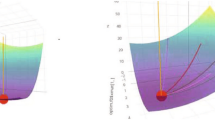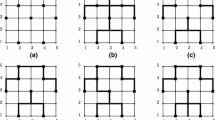Abstract
In this paper we develop, study and test new neighborhood structures for the Hop-constrained Minimum Spanning Tree Problem (HMSTP). These neighborhoods are defined by restricted versions of a new dynamic programming formulation for the problem and provide a systematic way of searching neighborhood structures based on node-level exchanges. We have also developed several local search methods that are based on the new neighborhoods. Computational experiments for a set of benchmark instances with up to 80 nodes show that the more elaborate methods produce in a quite fast way, heuristic solutions that are, for all cases, within 2% of the optimum.
Similar content being viewed by others
Explore related subjects
Discover the latest articles, news and stories from top researchers in related subjects.References
Ahuja, R., Ergun, O., Orlin, J., Punnen, A.: A survey of very large scale neighborhood search techniques. Discrete Appl. Math. 123, 75–102 (2002)
Cordeau, J.-F., Costa, A.M., Laport, G.: Fast heuristics for the Steiner tree problem with revenues, budget and hop constraints. Eur. J. Oper. Res. 190, 68–78 (2008)
Dahl, G.: The 2-hop spanning tree problem. Oper. Res. Lett. 23, 21–26 (1998)
Dahl, G., Flatberg, T., Foldnes, N., Gouveia, L.: The jump formulation for the hop-constrained minimum spanning tree problem. Working Paper no5, C.I.O. (2004)
Dahl, G., Gouveia, L., Requejo, C.: On formulations and methods for the hop-constrained minimum spanning tree problem. In: Pardalos, P., Resende, M. (eds.) Handbooks of Telecommunications, pp. 493–515. Springer, Berlin (2006)
Fernandes, M., Gouveia, L., Voss, S.: Determining hop-constrained heuristics with repetitive heuristics. J. Telecommun. Inf. Technol. (JTIT) 4/2007, 16–22 (2007)
Gouveia, L.: Using the Miller-Tucker-Zemlin constraints to formulate a minimal spanning tree problem with hop constraints. Comput. Oper. Res. 22, 959–970 (1995)
Gouveia, L.: Multicommodity flow models for spanning trees with hop constraints. Eur. J. Oper. Res. 95, 178–190 (1996)
Gouveia, L.: Using variable redefinition for computing lower bounds for minimum spanning and Steiner trees with hop constraints. INFORMS J. Comput. 10, 180–188 (1998)
Gouveia, L., Requejo, C.: A new Lagrangian relaxation approach for the hop-constrained minimum spanning tree problem. Eur. J. Oper. Res. 132, 539–552 (2001)
Gouveia, L., Simonetti, L., Uchoa, E.: Modelling the hop-constrained minimum spanning tree problem over a layered graph. In: Proceedings of the INOC 2007 Conference, Spa, 2007
Gruber, M., Raidl, G.R.: Variable neighborhood search for the bounded diameter minimum spanning tree problem. In: Proceedings of 18th Mini Euro Conference on Variable Neighborhood Search, Tenerife, Spain (2005)
Gruber, M., van Hemert, J., Raidl, G.R.: Neighbourhood searches for the bounded diameter minimum spanning tree problem embedded in a VNS, EA and ACO. In: Proceedings of GECCO’06, Seattle Washington (2006)
Manyem, P., Stallmann, M.: Some approximation results in multicasting. Working paper, North Carolina State University (1996)
Orlin, J., Sharma, D.: Extended neighborhood: definition and characterization. Math. Program. 101, 537–559 (2005)
Potts, C., van de Velde, S.: Dynasearch—iterative local improvement by dynamic programming—Orat 1: the traveling salesman problem. Technical Report, University of Twente (1995)
Voß, S.: The Steiner tree problem with hop constraints. In: Sharaiha, Y., Beasley, J. (eds.) Advances in Combinatorial Optimization Annals of Operations Research, vol. 86, pp. 321–345 (1999)
Woolston, K., Albin, S.: The design of centralized networks with reliability and availability constraints. Comput. Oper. Res. 15, 207–217 (1988)
Author information
Authors and Affiliations
Corresponding author
Rights and permissions
About this article
Cite this article
Gouveia, L., Paias, A. & Sharma, D. Restricted dynamic programming based neighborhoods for the hop-constrained minimum spanning tree problem. J Heuristics 17, 23–37 (2011). https://doi.org/10.1007/s10732-009-9123-5
Received:
Revised:
Accepted:
Published:
Issue Date:
DOI: https://doi.org/10.1007/s10732-009-9123-5




